1970: Super Bowl V - Dallas Cowboys vs Baltimore Colts
This series covers the history of the NFL through the prism of its yearly championship games.
Note: The gray boxes contain asides that provide interesting material but could be skipped
without losing the continuity of the article.
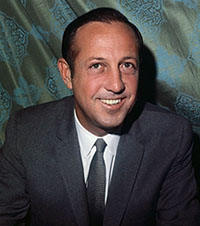
Pete Rozelle

Original Monday Night broadcast team: Howard Cosell, Keith Jackson, Don Meredith

Don McCafferty

Don Klosterman
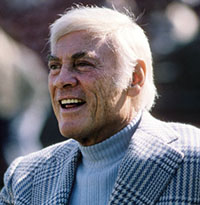
Carroll Rosenbloom
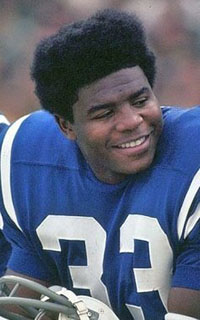
Eddie Hinton
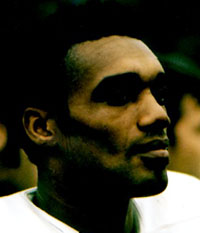
Roy Jefferson
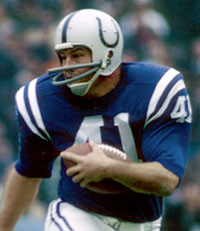
Tom Matte
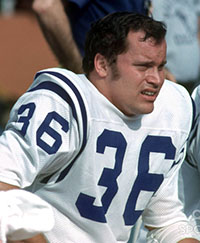
Norm Bulaich
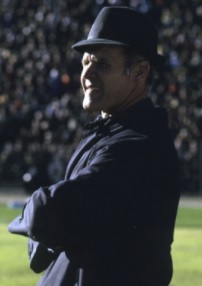
Tom Landry
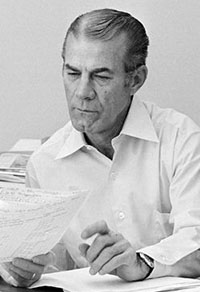
Ermal Allen
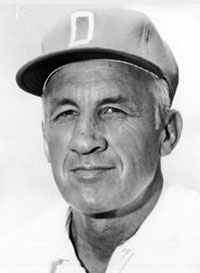
Jim Myers
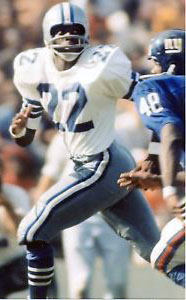
Bob Hayes
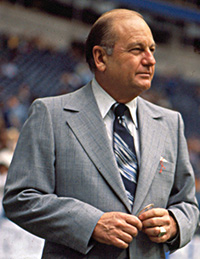
Tex Schramm

Herb Adderley
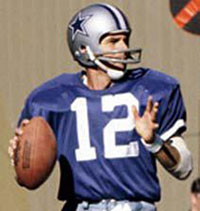
Roger Staubach
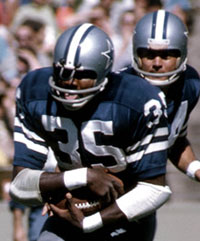
Calvin Hill
Walt G
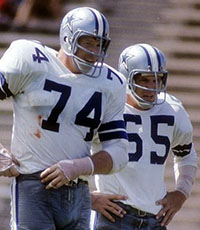
Bob Lilly and Lee Roy Jordan
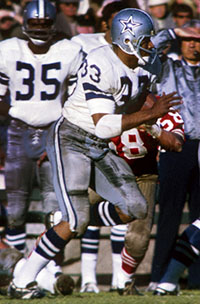
Duane Thomas runs against 49ers in NFC Championship Game
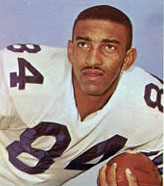
Pettis Norman

John Mackey, President NFLPA
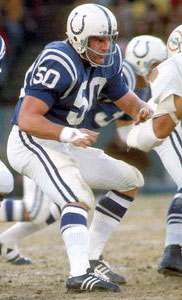
Bill Curry
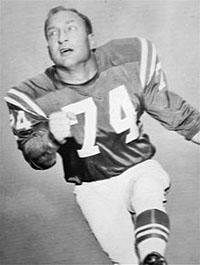
Billy Ray Smith
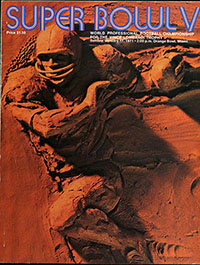
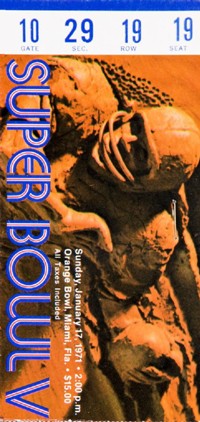
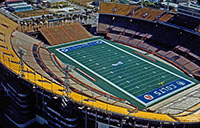
Orange Bowl Stadium with artificial turf
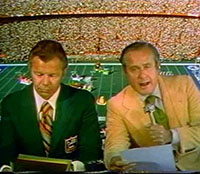
Kyle Rote and Curt Gowdy
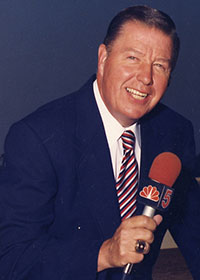
Jay Randolph
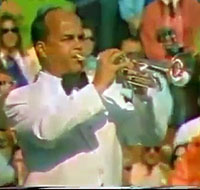
Tommy Loy plays national anthem
|
The merger between the American Football League and the National Football League became complete for the 1970 season.
- With ten AFL teams and 16 NFL teams, three teams had to switch from the National Conference to the American Conference to balance them.
- The Baltimore Colts, Cleveland Browns, and Pittsburgh Steelers agreed to change conferences. Each received $3M as a reward, the payment being prorated among the 13 remaining NFC teams.
- Each conferences was divided into three divisions for 1970.
National Conference
| NFC East |
NFC Central |
NFC West |
| Dallas Cowboys |
Chicago Bears |
Atlanta Falcons |
| New York Giants |
Detroit Lions |
Los Angeles Rams |
| Philadelphia Eagles |
Green Bay Packers |
New Orleans Saints |
| St. Louis Cardinals |
Minnesota Vikings |
San Francisco 49ers |
| Washington Redskins |
|
|
American Conference
| AFC East |
AFC Central |
AFC West |
| Baltimore Colts |
Cincinnati Bengals |
Denver Broncos |
| Boston Patriots |
Cleveland Browns |
Kansas City Chiefs |
| Buffalo Bills |
Houston Oilers |
Oakland Raiders |
| Miami Dolphins |
Pittsburgh Steelers |
San Diego Chargers |
| New York Jets |
|
|
- Each team played two of its 14 regular season games against opponents in the opposite conference.
- Pete Rozelle, the Commissioner of the NFL since 1960, retained that title after the merger. Kansas City Chiefs owner Lamar Hunt, the founder of the AFL, was named President of the American Conference. George Halas , one of the founders of the NFL, was given a similar title for the National Conference.
- Conflicting rules between the two leagues were adjusted as follows:
The two-point conversion option of the AFL (and college football since 1959) was eliminated and would not be reinstated until 1994.
The AFL's custom of putting the names of players on the backs of their jerseys was applied to all teams.
The slightly fatter Wilson ball used by the NFL was mandated for all games.
The scoreboard clock would be the official timer for all games.
- From the fans' viewpoint, the most significant innovation of the 1970 season was the introduction of Monday Night Football games by ABC-TV.
As summer training camps opened, the players struck over disagreements with owners.
- The players' #1 demand was a better pension plan - $26M distributed to veterans with four or more years of service. The owners budgeted only $18M for those veterans.
- The strike lasted only five days and resulted in a compromise on pension plans, disability payments, and other benefits.
The playoffs in each conference consisted of the three division winners plus a wild card - the second place team with the best record.
- So an additional week was added to the post-season.
Week One - Divisional Playoffs
The team with the best record in the conference vs the wild card team. Exception: If these two teams were from the same division, then the wild card team played the team with the second-best record.
The teams with the second and third best records played each other.
Week Two - Conference Championships
The winners of the two Divisional Playoff games in each conference met for the Conference Championship.
- Playoff Results
Divisional Playoffs
NFC
Dallas 5 Detroit 0, San Francisco 17 Minnesota 14
AFC
Baltimore 17 Cincinnati 0, Oakland 21 Miami 14
Conference Championships
NFC
Dallas 17 San Francisco 10
AFC
Baltimore 27 Oakland 17
As luck would have it, Super Bowl V paired two teams that were in the NFL the year before - Baltimore and Dallas.
- The Baltimore Colts had undergone three significant changes since they were upset by the New York Jets in Super Bowl III.
Ernie Accorso saw first hand why the Colts needed to make changes when he took the job as press manager. When I got to Baltimore in late winter '70, I was astonished at the whole mental state of that organization. They had not recovered from Super Bowl III still.
- First, they had a new coach, 49-year-old Don McCafferty, who was promoted from an offensive assistant position when Don Shula took the head coaching job with the Miami Dolphins after the 1969 season. Baltimore also had a new General Manager, Don Klosterman. (More Dons than a Mafia convention!)
A disciple of Paul Brown, Shula was once described as respected as a tactician but never popular with the players. When he left, DE Bubba Smith said, Fine, maybe we'll get a coach now who'll treat us like human beings instead of dogs. Like many black players, Bubba didn't like being yelled at.
Nicknamed "Easy Rider" by the players, McCafferty was the antithesis of Shula - easy-going, friendlier, tolerant of individuality as long as the player produced on the field. Fortunately, the new Don inherited a veteran team that disciplined itself and didn't need micromanaging.
Smith: McCafferty is beautiful, man. He doesn't holler at all. He's human, too. The other night he sat in on a poker game the guys were having. Shula never did anything like that. McCafferty sits right down, wins a $50 pot and then leaves. ... As a coach, he's never tried to fool us about anything. He just lays it on the line. He hasn't got any set way, and everybody on this team will go out and break his neck for the guy.
Colts owner Carroll Rosenbloom, who demanded - and got - a #1 draft pick from Miami in compensation for their signing Shula, praised McCafferty after Baltimore beat Oakland to win the 1980 AFC crown and vented some of his bitterness toward his previous coach: That kicks the genius coach theory into a cocked hat. Mac took a team that looked like nothing last year (8-5-1), a team riddled with dissension and often hurt this season, and turned it into a champion. Here is a man who has no inner sanctum, no pretensions, no assistants - only associates. Everybody gets the credit except McCafferty. He is just a splendid man. What's more, he brought the fun back into the game of football for me.
Morrall: After Shula defected to Miami ... I was a bit apprehensive. I thought the easy-going, sweet-tempered McCafferty might be too lenient, and that some of the guys would take advantage of him. But it never happened. McCafferty held the team in firm control all the way. The methods he used were different. Whereas Shula might scream at a player for making a mistake, McCafferty would have a private chat with him.
- 37-year-old Johnny Unitas had taken back the starting QB role from Earl Morrall for the 1969 season. Then he had his best season in five years in 1970. But even though the Colt legend threw for 2,213y that year, he finished the season with a career-low 51.7% completion rate. Johnny U. also threw more INTs (18) than TDs (14). Still, he was Mr. Clutch in the playoff games against Cincinnati and Oakland. When Unitas's shoulder injury flared up, Morrall replaced him for most of three games, two early in the season and Earl's personal redemption victory against the Jets in the season finale.
C Bill Curry summarized the mystique of Johnny U. Unitas'd come in - of course, his track record had a lot to do with it - and there was something about being in a huddle with him with a minute and 45 seconds left, and you needed a touchdown, and you were back on your own 20y line. Everybody'd look over at that famous crooked nose with the scar down it. He sort of blinked his eyes behind the bar on his helmet, and you'd know you were going to get a touchdown. And we would. It was all so matter-of-fact with him. There was very seldom a pep talk. He might say to Jimmy Orr or Roy Jefferson, "What ya got? Can you get him on an up? Can you beat him on an out? Is he playing you inside? Okay, let's try it out this time." He'd stick his head in the huddle and call the play, boom. He assumed that we were going to keep a pass rush off of him, and that if we did we were going to win the game. He might say, "Let's go, keep them out, okay?" It was all very ... laconic. Just straightforward business. "Let's go do it. Here we go."
- Unitas enjoyed throwing to two young, fast WRs in 23-year-old Eddie Hinton and 27-year-old Roy Jefferson. The pair finished 1-2 on the club in receptions and yardage, combining for 91 catches and 1482y.
- The Colt running game took a hit - literally and figuratively - when veteran HB Tom Matte injured a knee in the second game. He spent the rest of the season as a backfield coach. Norm Bulaich took his place and led the team with 426y to relieve some of the pressure on Unitas.
- It was defense where Baltimore excelled. Eight starters from the '68 NFL champions' defense returned and helped the Colts finish second in the AFC in points allowed, trailing the Dolphins by only six points.
Don Shula had revamped the Colts' pass defense the year after the Super Bowl loss. Working with DB Bobby Boyd, who became an assistant coach for the '69 season, Shula devised a strategy to combat the short passes that Joe Namath had used so effectively in Super Bowl III. The Colts called it the double zone but in later years it became known as the cover-2. The CBs and LBs defended the short passes while the safeties dropped to guard against the bomb. Boyd recalled, Nobody else in the league was using it. Teams didn't know how to attack it. He credited the 1970 NFC Championship in part to its effectiveness.
- The Colts had a new place-kicker for 1970, rookie Jim O'Brien. DT Walt Michaels had done all the kicking since 1964. But he missed a 27y FG in Super Bowl III, then hit just 45.2% in 1969. So Michaels was cut at the end of the '70 preseason.
O'Brien recalled: The fact that I was competing in camp with a popular player made things a bit difficult for me with some of the veterans. Lou Michaels was one of their buddies, and here comes this young kid. They were older and very conservative, and most of them were married, and here I was young and single and feeling my oats, so to speak. I exuded a lot of confidence and probably that was seen as my being brash or cocky. Also, I let my hair grown an inch longer than anybody else's.
Nicknamed "Lassie" by DT Billy Ray Smith, O'Brien helped win over his teammates when he booted a 19y FG in the final seconds to beat San Diego 16-14 on opening day.
The Cowboys had endured five years of frustration as they entered the 1970 season.
- They lost two years in a row to the Packers in the NFL title game, the first at home in 1966 and the second in the "Ice Bowl" at Green Bay in '67, with both games not decided until the final seconds.
- After losing to the Browns in the Division Playoffs each of the next two seasons, Dallas was being referred to as "Next Year's Champions" but not in a flattering way.
- The year after the first Cleveland loss, Landry told the players that he wanted even more dedication, more seriousness, more hard work. No kidding around at practices, which were strictly business.
- Following the second season-ending Cleveland loss, Tom decided to take a different approach for the 1970 season - involve the players more. So he mailed each player a lengthy questionnaire about every aspect of life as a Cowboy.
- After analyzing the questionnaires (probably with the help of a computer since the Cowboys were the pioneers of pro football in the use of the new machines for scouting and talent evaluation), Landry made some modifications in his coaching staff. He changed Ermal Allen's designation from Backfield Coach to Special Assistant and charged him with breaking down film of opponents. 26-year-old Dan Reeves, still on the active roster, was made Running Backs Coach. Jim Myers, the Offensive Line Coach, was in effect made the offensive coordinator, a term not used yet. Tom also tightened up discipline in a few ways, such as not allowing players to lay their helmets down during practices. Also the team watched films of the previous games on Monday and had Tuesdays off instead of the other way around.
- More importantly, Tom decided there would be less reliance on big plays such as the bombs to WR Bob Hayes, labeled "The World's Fastest Human" after winning two gold medals at the 1964 Olympics. Instead, more emphasis would be placed on the running game.
- Adding to Landry's challenge for 1970 was the underlying bitterness among the veteran players regarding GM Tex Schramm's refusal to bring their salaries up to the league average even though the team had been one of the best in the NFL for years. In particular, the veterans resented Schramm's attitude that asking for a raise was a sign of disloyalty. "Take it or leave it" was his approach in that era before free agency. The players thought Tex should exhibit more loyalty toward them for their contributions to the team.
RB Duane Thomas, the club's #1 pick in the 1970 draft, was shocked to learn that he was making more as a rookie than DT Jethro Pugh, a six-year veteran. The black players like Pugh figured out that Schramm in general paid more to white players than black players. Calvin Hill noticed that none of the black stars were offered endorsement or commercial opportunities.
MLB Leroy Jordan recalled: Most of us were unhappy with the money we were making. The Cowboys were making a fortune ... It was a problem for us to accept why we were winning and doing as well as we were, while we were the second-lowest-paid team in the league.
DB Ray Renfro: We were hearing that other teams and other players were making good money. We were hearing this from the opposing players. The word was getting out that there were some guys out there making good money, and they didn't have half the success the Dallas Cowboys were having. I heard that Larry Wilson of the Cards was making almost $100,000, and I was making $35,000. And I had the same credentials as Larry Wilson.
The Cowboys voted strongly to go on strike at the beginning of training camp to get better pension benefits.
- Landry announced at the beginning of training camp in '70 that he was establishing minimum performance levels, position by position. Any player who failed to attain the required level would lose his starting job. One of the first casualties of the new approach was Hayes. The WR, entering his fifth season with the club, had failed to show up regularly for the mandated off-season training program and therefore didn't have the physical fitness to meet his performance requirements.
Hayes was certain that the real reason he was being benched was that he entered the season playing out his option and had publicly complained about Schramm's low salaries. Bob's demotion also provoked charges of racism because Dennis Homan, a slower white guy, took Bullet Bob's job.
Landry ultimately reinserted Hayes in the starting lineup in the Thanksgiving Day game against Green Bay, which Tom said afterward was, The best game I've ever seen Bob Hayes play.
- A few weeks before the season began, Dallas made a trade that gave them the best secondary in the NFL. They traded two second-line players to the Packers for CB Herb Adderley, a starter on all five of Vince Lombardi's championship teams of the 1960s. To make room for the nine-year veteran, Cornell Green moved to strong safety. Combined with the other CB, Mel Renfro, the trio had played in 14 Pro Bowls.
Adderley liked to play a gambling style that didn't sit well with Landry. In an era of bump-and-run technique that the AFL popularized, Herb liked to play off the line of scrimmage. He'd trick the QB into thinking his man was open, then accelerate to the ball and knock it down or intercept. But Landry's defense used zone coverages. Herb: The kind of defensive scheme Dallas used always went against my basic philosophy. In Green Bay we played about 90% man-to-man. I had the freedom to line up where I want to ... I never felt comfortable playing the Dallas type defense. Even when I would make a big play or an interception, it seemed I was out of position or something. I just never really got the feel for it. And I think Landry recognized the difficulty I was having, because on some occasions he would allow me to just go ahead and play man-to-man while we were actually supposed to be in some other kind of coverage. Adderley credited Renfro with teaching him a great deal about the Dallas coverages.
Renfro: Herb brought a lot of attitude with him. He knew how to win. They (Green Bay) won when they weren't even that good. But Lombardi knew how to win, and he (Adderley) brought a little of that attitude with him. He screamed at us in the locker room a couple of times, and no one had ever done that. Coach wouldn't scream at us, but Herb did, and he got our attention.
Green agreed. Herb was a guy who made plays for us. He gave us confidence because he knew how to play and win big games.
White LB D. D. Lewis: Tom had a bit of a racial problem, and a key addition in 1970 was getting Herb Adderley. He came preaching brotherly love. ... He was the enzyme we needed.
- Like the Colts, the Cowboys would hang their hat on their veteran defense. Nine of the starters on that side of the ball had played at least five seasons and four of those had survived eight or more campaigns.
- Landry continued to polish his "Flex" defense based on the "Umbrella" defense he had learned from Steve Owen with the Giants and taught as Giants' defensive coordinator in the late '50s.
The Flex was a 4-3 defense with one down tackle and one down end "flexed" a few feet off the line of scrimmage in a zigzag pattern. The idea was to give each flexed lineman an extra second to see the flow of the play before attacking. Landry also set his ends and tackles in gaps between offensive linemen. That made them more difficult to option-block. He asked each down lineman to control the gap they were assigned. The three LBs were asked to do the same. Landry was willing to reduce his defense's chance of throwing a RB for a loss in order to decrease the chance of giving up a big gain.
Midway through the 1970 schedule, the Cowboys seemed to have no chance at making the playoffs despite Landry's changes.
- First of all, the season started with a QB controversy. Landry benched Craig Morton, his starter in 13 games in 1969, because Craig had not returned from his off-season shoulder surgery in better shape. So Roger Staubach, the Naval Academy graduate in his second season with the club after completing his military obligation, started the first two games of the regular season until Morton's shoulder soreness abated.
Staubach was too emotional and instinctive for Landry's taste in QBs and too quick to call an audible or bolt from the pocket. Tom preferred a QB like Morton who was an extension of his own computer-like brain. Already 29 after serving four years in the Navy, Staubach hated the dual QB setup and planned to ask for a trade when the season ended.
Morton also disliked sharing the position. He lost so much confidence that he started seeing a hypnotist during the season.
- After starting 3-1, the Cowboys were clobbered by the Vikings in Minnesota in Week 5, 54-13. Still, Landry didn't make any significant changes, and his 'Boys rebounded to win their next two games before losing to the Giants on the road 23-20.
- The turning point in the season was a humiliating 38-0 home loss to the St. Louis Cardinals the following week on the Monday night national telecast.
Don Meredith, the Cowboys' QB from 1962-68 who was part of the Monday Night Football broadcasting team, commented during the rout, This ain't the Cowboy team I used to know. When those remaining in the stands started chanting, We want Meredith!, Don said, I'm not about to go back down there. He refused to sing his signature "Turn out the lights, the party's over!" song in deference to his former team and coach.
- Right after the Monday night game, Landry told the team how disappointed he was. At the beginning of the season, he thought they had a chance to go to the Super Bowl, but now they were 5-4 with almost no hope of making the playoffs. He apologized for not doing a better coaching job. Many players got the distinct impression that he had given up on the season.
- The next day, the players braced for a brutal film session. But Landry surprised them. Near tears, he told the team, Y'all can just play flag football if you want. Then he tossed his clipboard and walked out. DT Bob Lilly and LB Lee Roy Jordan decided to hold a meeting right then and there. Jordan told the team, Hey guys, there is no one pulling for us but us, the guys right here in this room. Hell, the coaches aren't pulling for us. They've already given up. ... We know damn well the press has been against us forever so they're not pulling for us. And most of the fans are not excited about us anymore. ... Guys, it's going to happen right here in this room or it's not going to happen." Several of us talked. We said, "We are going to do it for us, not for somebody else, not for the coaches or the fans or Tex or anyone else."
G Blaine Nye: After we lost the game to the Cardinals, Tom decided the season was over. He let go and started taking a lighter approach. We'd go out and play touch football or volleyball on Mondays, things like that. Suddenly, it got to be fun, and the team began to do better. For a reason that I still can't explain, there was suddenly the feeling that you were a part of this unified effort ...
Renfro: People had written us off. The season was over. Coach Landry relaxed his practices a little and kind of threw out the play book and said, "You guys have some fun the rest of the year."
- After the meeting, the intensity at practice changed. Jordan: We got after each other. The next day in practice we were competing against the offense, and they were competing against us, hard.
Lee Roy explained: When you don't practice intense against yourself, you don't play intense against somebody else. ... By golly, we beat Washington. It wasn't a real great game, but we played hard, won the game, and then we went to Green Bay and held them to three points, and now all of a sudden everyone is getting excited about us again. The coaches got to coaching real heavy again. ... We talked about game plans with the coaches, and we were much more involved in expressing our feelings about what we were doing in the game plans.
The Cowboys won the last five games of the season to finish 10-4, good enough to win the NFC East.
- Dallas made the playoffs despite both their QBs playing with significant injuries all season. Morton had his right elbow drained before every game and hurt his knee in the Minnesota game. Staubach endured an infected right elbow.
Morton threw four TD passes to the resurrected Bob Hayes in the 52-10 rout of the Houston Oilers in the final game of the regular season.
- You can overcome offensive deficiencies if you have a great defense. Jordan & Company gave up just eight points in the last four games, then got even better in the NFC playoffs, shutting out Detroit 5-0 and holding the potent 49ers to just ten points in the NFC championship game at San Francisco. After the game, the usually stoic Landry broke into a big smile. You don't know how good this feels, he said.
When San Francisco scored in Q3, it ended Dallas's streak of 23 straight quarters without allowing an offensive TD.
TE Pettis Norman, a nine-year veteran, said he had never enjoyed the final weeks of a season like he had the one that just ended. It used to be, if you dropped a pass, you'd come back to the bench and 30 heads would turn away from you. Now you get everybody rushing up to you to tell you it's okay, forget it, don't worry about it. Catch the next one.
Lilly: The pressure was removed. ... After the St. Louis game, Landry was still in control but let the assistants use more of their ideas. We started dealing with our own coach.
- Along the way, the Cowboys fulfilled one of Landry's goals for the season. Dallas ranked in the middle of the league in passing yardage but at the top in rushing yards. Even though he didn't start until the fifth game, the leading runner was enigmatic rookie Duane Thomas with 803y. Next was the 1969 AP NFL Offensive Rookie of the Year Calvin Hill at 577 despite spending time in the hospital because of an infected blister on his foot and then a broken toe. Reliable FB Walt Garrison added 507y.
Garrison was the only Dallas Cowboy who was a real cowboy. During the offseason, he competed on the rodeo circuit. He was also an Oklahoma State Cowboy during his college football career.
- Despite two games in which they were torched for 54 and 38 points, the Cowboys finished 4th in the NFC in points allowed.
- Dallas was also known for their special teams, which were manned by speedsters who would start on other clubs.
Trying to forget their disastrous trip to the Super Bowl in Miami in 1969, the Colts did everything differently this time.
- They flew from frigid Baltimore to south Florida ten days before the game on a different airline, stayed at a different site (a country club rather than a beachfront hotel), and practiced on a different field.
- The Colts were motivated by two factors: First, vindicating themselves for their loss to the Jets in Super Bowl III, and proving to the pro football world that they could win the big game without the "genius" of Don Shula.
Bubba Smith, who would announce his retirement in the locker room after Super Bowl V, recalled the Colts' attitude two years earlier. We walked out of the hotel that morning (of Super Bowl III) like the Jets were going to be too scared to show up. The Jets stole our pride and everything else. We have to get it back.
- Time magazine printed this in its preview of the game: The Colts are a plodding and unspectacular team, which reflects, in part, the unobtrusive personality of their first-year head coach.
- One Colt who attracted attention from the media was TE John Mackey, the president of the players' association and leader of the strike that shut down training camps back in August. He was asked if the three-day walkout improved the relationship between players and owners. Yes and no. Some things have been solved, and some things haven't. In two weeks, after the Pro Bowl in Los Angeles, we'll have a meeting and decide where we're going. He refused to discuss player-owner matters any further. I've got a game to get ready for. But he did respond to a question about how much the loss to the Jets motivated the Colts. I think of sitting around at half time of that game two years ago, and how bad it was, how unprepared we were. ... I dropped a few passes in that game, but I'm not haunted by them. ... I was low, man, real low for five, six months. I remember feeling like I wanted to dig a hole and hide until the next season started.
- Earl Morrall was also asked if he endured any lingering effects from his poor performance in Super Bowl III. That was the biggest game of my life, and it didn't turn out too well. I've tried to shrug it off, but I just can't. I keep thinking about it, and I still get flashbacks, remembering all the bad things and all of the turning points. I've replayed in my mind that whole game over and over again. The interceptions, the flea-flicker, the whole mess. Now that I'm back at the Super Bowl, I'll be returning to the scene of the crime. I guess there is no way I can escape it.
Morrall wrote in his 1971 autobiography: I was somewhat dejected as the day of the game (Super Bowl V) drew near. I figured that I was going to be a spectator, that I wasn't going to get a chance to play unless things went badly for us or we managed to get way ahead.
- Reporters also wanted to talk to Johnny Unitas, who had gained a (deserved) reputation for being curt with the press. He agreed to two sessions early in the week and actually seemed to enjoy them.
Unitas's image contrasted sharply with that of Joe Namath, the hero of the AFL for leading the Jets to victory in Super Bowl III. John was considered a model citizen - family man, businessman, crew cut, quiet, calculating team leader. Namath cultivated his playboy image - long hair, a different knockout young lady on his arm each time he was seen in public, flinging passes with abandon. However, unknown to the public, Unitas was burdened with personal problems that would culminate in his wife filing for divorce five days after Super Bowl V. John also admitted after the Super Bowl that he had suffered from headaches ever since the Cincinnati playoff game.
Dallas arrived a week before the game and moved into their lodging and training sites in Fort Lauderdale, where the Jets had prepared two years earlier.
- Unlike the Colts, who had their wives with them, the Cowboys were not even allowed to speak to their wives, who fended for themselves in South Florida.
- The Cowboy who made the most splash nationwide when he spoke to the press was Duane Thomas, who already had a reputation for being "different." Asked if he felt pressure as a rookie as he approached the Super Bowl, Duane replied, I don't believe in pressure. But this is the ultimate game, how can you not feel pressure? No, it isn't, he said. It's not the ultimate game? If this was the ultimate game, they wouldn't be playing it again next year.
- Sports Illustrated, in its preview of Super Bowl V, called the Cowboys "a team without a QB." The upcoming game was painted as Johnny Unitas vs. the Dallas defense.
- Craig Morton was asked if he minded Coach Landry calling all the plays. Tom started calling the plays because he thought I'd gotten too conservative. Also, he thought maybe I was being affected by the static we were getting from the fans. And we won that game, so he called them the next week, too. And we kept winning, so you don't change a winning combination. ... Our philosophy right now on offense is not to make mistakes, control the ball. We have a great running game going, so we stay with it. We've won seven in a row, and I've had two interceptions in those seven games, no fumbles.
- One Cowboy who was especially excited to be in the Super Bowl was rookie S Charlie Waters. A year ago this time, I was sitting in a frat house at Clemson, watching the Super Bowl game on television. I had just had shoulder surgery. I was so convinced something like this was out of my reach that I didn't even bother to dream about it.
Years later, LB Chuck Howley looked back at Super Bowl V and said: We acted like it was just another game, but it wasn't. It was the Super Bowl. We wanted to win it, but I don't know if we had the urgency we needed in a game of that magnitude.
TE Pettis Norman later pointed to the two-week layoff between the NFC Championship Game and the Super Bowl as a factor in how Dallas played in the big game. The 49er championship game was better from an emotional standpoint than the Super Bowl. First of all, there was a two-week lag time. To me, you lose some edge when you wait like that and then you try to get it back. We went to the Orange Bowl in Miami, and the atmosphere was not quite real. It was really kind of boring. You get tired of going through thousands of interviews, posing for pictures, this and that.
With Baltimore, a former NFL team, representing the AFC, Super Bowl V lacked the upstart league vs. establishment flavor of the first four contests.
- The Colts came to Miami feeling unloved and unappreciated. We came into a new league this season, and nobody wanted to see us win the championship, said C Bill Curry. And they still don't.
- Colts DT Billy Ray Smith said, I don't want to win one for the old AFC. I want to win one for old B.R. and the Colts. This will be my last game ... Why shouldn't I feel that way? We've been in the AFC for one season - how in hell can the league identify with us, and vice-versa? We're still the Colts the Jets beat to a lot of people in the league. Nobody's sending us telegrams this year.
- Unitas was succinct. My only allegiance is to Baltimore.
- Nevertheless, the game had been sold out for weeks except for 1,000 tickets that would be available to walk up customers. The NFL office announced that tickets for the end zone sold faster at $15 each than they had three years earlier at $6 each for the Packers-Raiders Super Bowl in the same stadium. PR Director Don Weiss said, We could have sold 100,000 tickets for this game if we had the room.
Landry made some changes in his offensive lineup the week of the game.
- Calvin Hill, a forgotten man the last two months, was running with the first team. Duane Thomas moved over to FB in place of Walt Garrison, who came out of the 49ers game with a badly twisted ankle to go along with the strained knee and chipped collarbone he already had.
- Landry and his staff gave the offensive players a 45-page notebook with the game plan to combat the Colts' every-changing defenses.
- Once the game began, the play-caller on the sideline - Landry himself, would start eliminating plays. You find out quickly what's going to work against their defenses, said offensive coach Jim Myers, and then you throw out what won't work. The process of elimination. When you settle on what is going to work, you keep repeating it. That's the big factor, to repeat and repeat and repeat.
- Landry was asked if his team was handicapped by the "Can't win the big one" syndrome. This season we've laid that one to rest. We won tough games over Green Bay, Cleveland, Detroit, and San Francisco when a loss would mean we were out of it. That idea might have been a problem at one time, though I doubt it. But it's certainly not now.
- The day before the game, Landry announced he was starting Garrison at FB despite all his injuries. Garrison has been improving each day, Tom explained. Right now he's 75% of himself, but by game time we feel he should be close to 100%. We're going to go with him. He has been limping, but when he has the ball under his arm, he runs hard. Landry implied that who started on offense was unimportant. The defense will control this game. It always does in the Super Bowl.
- And Tom's defense, which had ranked in the top three in rushing defense dating back to 1965, was confident they could stop the Colts' running game. Baltimore had no outside runners with Norm Bulaich, a power runner at HB, and less-than-fleet FB Tom Nowatzke. So the game plan was to make Unitas beat them through the air.
- Dallas reporter Steve Perkins was treated to an inside look at the Cowboys' analysis of the Colts offense. When Steve asked backfield coach Ermal Allen, You think Dallas can handle Unitas?, Allen invited Perkins to his hotel room where he showed a diagram he had made while watching film of the Colts. His chart showed where each pass Unitas had thrown traveled on the football field. Circled numbers indicating completed passes were almost all clustered in the middle of the field with just four completions near the sidelines. Is his arm gone? Steve asked. Ermal replied, I don't know anything about this arm. I just know he throws to the middle.
- In addition to his elbow and shoulder miseries, Morton also battled a case of laryngitis that, fortunately, cleared up by game time.
Morton had a disturbing experience the morning of the Super Bowl while walking along the beach by the team's hotel. I saw Duane (Thomas) sitting there on the curb with his head down. He looked zonked. I don't know what he was on, but it scared the hell out of me. I mean, here was a guy who was supposed to be my main man this afternoon. Well, he got back to the hotel, and before the kickoff he gave me this big wink, so I knew he was all right, I guess.
White LB Steve Kiner, who shared an apartment with Thomas, admitted in later years that the two of them smoked pot. He also said they talked about taking mescaline before the Super Bowl.
Jimmy "The Greek" Snyder, hoping to restore his reputation after two bad failures in Super Bowls III and IV when he badly underestimated the strength of the Jets and Chiefs, made Dallas a one-point favorite.
- Other oddsmakers ranked the game dead even - a "pick it."
- Marty Ralbovsky of The New York Times predicted a dull, unexciting game. The bland leading the bland.
NBC telecast the game nationwide and beamed the radio broadcast around the world.
|
1970 Baltimore Colts
| # |
Player |
Pos. |
Hgt. |
Wgt. |
College |
Exp. |
| 15 |
Earl Morrall |
QB |
6-1 |
205 |
Michigan State |
13 |
| 17 |
Sam Havrilak |
RB |
6-2 |
195 |
Bucknell |
2 |
| 19 |
Johnny Unitas |
QB |
6-1 |
195 |
Louisville |
11 |
| 20 |
Jerry Logan |
S |
6-1 |
185 |
West Texas A&M |
8 |
| 21 |
Rich Volk |
S |
6-3 |
195 |
Michigan |
4 |
| 27 |
Ray Perkins |
WR |
6-3 |
185 |
Alabama |
4 |
| 28 |
Jimmy Orr |
WR |
5-11 |
185 |
Wake For., Clem., Ga. |
13 |
| 30 |
Ron Gardin |
CB |
5-11 |
180 |
Cameron, Arizona |
1 |
| 32 |
Mike Curtis |
LB |
6-3 |
230 |
Duke |
6 |
| 33 |
Eddie Hinton |
WR |
6-0 |
200 |
Oklahoma |
2 |
| 34 |
Tom Nowatzke |
RB |
6-3 |
230 |
Indiana |
6 |
| 35 |
Jim Duncan |
CB |
6-2 |
200 |
MD-Eastern Shore |
2 |
| 36 |
Norm Bulaich |
RB |
6-1 |
220 |
TCU |
1 |
| 40 |
Jack Maitland |
RB |
6-2 |
210 |
Williams |
1 |
| 42 |
Tommy Maxwell |
CB |
6-2 |
195 |
Texas A&M |
2 |
| 45 |
Jerry Hill |
RB |
5-11 |
210 |
Wyoming |
10 |
| 47 |
Charlie Stukes |
CB |
6-3 |
210 |
MD-Eastern Shore |
4 |
| 49 |
David Lee |
P |
6-4 |
230 |
Louisiana Tech |
4 |
| 50 |
Bill Curry |
C |
6-3 |
235 |
Georgia Tech |
6 |
| 51 |
Bob Grant |
LB |
6-2 |
225 |
Wake Forest |
3 |
| 52 |
Robbie Nichols |
LB |
6-3 |
220 |
Tulsa |
1 |
| 53 |
Tom Goode |
C |
6-3 |
245 |
Mississippi State |
9 |
| 56 |
Ray May |
LB |
6-1 |
230 |
USC |
4 |
| 60 |
George Wright |
DT |
6-3 |
265 |
Sam Houston State |
1 |
| 61 |
Cornelius Johnson |
G |
6-2 |
245 |
Virginia Union |
3 |
| 62 |
Glenn Ressler |
G |
6-3 |
250 |
Penn State |
6 |
| 71 |
Dan Sullivan |
T |
6-3 |
250 |
Boston College |
9 |
| 72 |
Bob Vogel |
T |
6-5 |
250 |
Ohio State |
8 |
| 73 |
Sam Ball |
T |
6-4 |
250 |
Kentucky |
5 |
| 74 |
Billy Ray Smith |
DT |
6-4 |
240 |
Auburn, Arkansas |
14 |
| 75 |
John Williams |
G |
6-3 |
255 |
Minnesota |
3 |
| 76 |
Fred Miller |
RT |
6-3 |
250 |
LSU |
8 |
| 78 |
Bubba Smith |
DE |
6-7 |
265 |
Michigan State |
4 |
| 80 |
Jim O'Brien |
K |
6-0 |
195 |
Cincinnati |
1 |
| 81 |
Billy Newsome |
DE |
6-4 |
250 |
Grambling State |
1 |
| 83 |
Ted Hendricks |
LB |
6-7 |
220 |
Miami (FL) |
2 |
| 84 |
Tom Mitchell |
TE |
6-2 |
215 |
Bucknell |
5 |
| 85 |
Roy Hilton |
DE |
6-6 |
240 |
Jackson State |
6 |
| 87 |
Roy Jefferson |
WR |
6-2 |
195 |
Utah |
6 |
| 88 |
John Mackey |
TE |
6-2 |
225 |
Syracuse |
8 |
|
1970 Dallas Cowboys
| # |
Player |
Pos. |
Hgt. |
Wgt. |
College |
Exp. |
| 10 |
Ron Widby |
P |
6-4 |
210 |
Tennessee |
3 |
| 12 |
Roger Staubach |
QB |
6-3 |
195 |
Navy |
2 |
| 14 |
Craig Morton |
QB |
6-4 |
215 |
California |
6 |
| 20 |
Mel Renfro |
CB |
6-0 |
190 |
Oregon |
7 |
| 22 |
Bob Hayes |
WR |
6-0 |
185 |
Florida A&M |
6 |
| 24 |
Dennis Homan |
WR |
6-1 |
180 |
Alabama |
3 |
| 26 |
Herb Adderley |
CB |
6-0 |
205 |
Michigan State |
10 |
| 30 |
Dan Reeves |
RB |
6-1 |
200 |
South Carolina |
6 |
| 32 |
Walt Garrison |
RB |
6-0 |
205 |
Oklahoma State |
5 |
| 33 |
Duane Thomas |
RB |
6-1 |
220 |
West Texas A&M |
1 |
| 34 |
Cornell Green |
S |
6-3 |
210 |
Utah State |
9 |
| 35 |
Calvin Hill |
RB |
6-4 |
225 |
Yale |
2 |
| 41 |
Charlie Waters |
S |
6-1 |
195 |
Clemson |
1 |
| 42 |
Claxton Welch |
RB |
5-11 |
205 |
Oregon |
2 |
| 43 |
Cliff Harris |
S |
6-0 |
190 |
Ouachita Baptist |
1 |
| 45 |
Richmond Flowers |
S |
6-0 |
180 |
Tennessee |
2 |
| 46 |
Mark Washington |
CB |
5-10 |
190 |
Morgan State |
1 |
| 50 |
D.D. Lewis |
LB |
6-1 |
225 |
Mississippi State |
3 |
| 51 |
Dave Manders |
C |
6-2 |
250 |
Michigan State |
7 |
| 52 |
Dave Edwards |
LB |
6-1 |
225 |
Auburn |
8 |
| 54 |
Chuck Howley |
LB |
6-3 |
230 |
West Virginia |
13 |
| 55 |
Lee Roy Jordan |
LB |
6-1 |
220 |
Alabama |
8 |
| 56 |
Thomas Stincic |
LB |
6-4 |
230 |
Michigan |
2 |
| 60 |
Steve Kiner |
LB |
6-1 |
220 |
Tennessee |
1 |
| 61 |
Blaine Nye |
G |
6-4 |
250 |
Stanford |
3 |
| 63 |
Larry Cole |
DE |
6-5 |
250 |
Air Force, Hous., Hawaii |
3 |
| 66 |
George Andrie |
DE |
6-6 |
250 |
Marquette |
9 |
| 67 |
Pat Toomay |
DE |
6-5 |
245 |
Vanderbilt |
1 |
| 70 |
Rayfield Wright |
T |
6-6 |
255 |
Fort Valley State |
4 |
| 72 |
Tony Liscio |
T |
6-5 |
265 |
Tulsa |
8 |
| 73 |
Ralph Neely |
T |
6-6 |
265 |
Oklahoma |
6 |
| 74 |
Bob Lilly |
DT |
6-5 |
260 |
TCU |
10 |
| 75 |
Jethro Pugh |
DT |
6-6 |
260 |
Elizabeth City State |
6 |
| 76 |
John Niland |
G |
6-3 |
245 |
Iowa |
5 |
| 77 |
Ron East |
DT |
6-4 |
250 |
Montana St., Ore. St. |
4 |
| 78 |
Bob Asher |
T |
6-5 |
250 |
Vanderbilt |
1 |
| 83 |
Mike Clark |
K |
6-1 |
205 |
Texas A&M |
8 |
| 84 |
Pettis Norman |
TE |
6-3 |
220 |
Johnson C. Smith |
9 |
| 88 |
Reggie Rucker |
WR |
6-2 |
195 |
Boston U. |
1 |
| 89 |
Mike Ditka |
TE |
6-3 |
230 |
Pittsburgh |
10 |
|
References: Comeback Quarterback: The Earl Morrall Story, Earl Morrall and George Sullivan (1971)
Super Bowl: Of Men, Myths and Moments, Marty Ralbovsky (1971)
The Dallas Cowboys: Winning the Big One, Steve Perkins (1972)
God's Coach: The Hymns, Hype, & Hypocrisy of Tom Landry's Cowboys, Skip Bayless (1990)
America's Game: The Epic Story of How Pro Football Captured a Nation, Michael MacCambridge (2004)
Game of My Life Dallas Cowboys: Memorable Stories of Cowboys Football, Jean-Jacques Taylor (2006)
Johnny U: The Life and Times of John Unitas, John Callahan (2006)
A Cowboy's Life, Bob Lilly with Kristine Setting Clark (2008)
The Ultimate Super Bowl Book, Bob McGinn (2009)
The Dallas Cowboys: The Outrageous History of the Biggest, Loudest, Most Hated, Best Loved Football Team in America: Joe Nick Patoski (2013)
The NFL, Year One: The 1970 Season and the Dawn of Modern Football, Brad Schultz (2013)
The NFL in the 1970s, Joe Zagorski (2016)
|
|




























